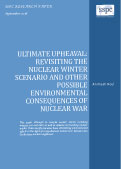STATEMENT: "OPCW and CW threats posed by extremist groups and insincere nation states"
Presentation to the 23rd CWC Conference of States Parties (CSP) Organization for the Prohibition of Chemical Weapons, The Hague, The Netherlands, November 23, 2018
Mr Chairman, Director-General, Distinguished Delegates, Ladies and Gentlemen, It’s an honour to be present at the 23rd Conference of States Parties (CSP-23) and the 4th Review Conference of the Chemical Weapons Convention.
Cooperation or Competition with China in the Indian Ocean: An Indian Perspective
About one-fifth of the total oceanic area in the world is covered by the Indian Ocean region. It is bound by the Arabian Peninsula and Africa, collectively known as the western Indian Ocean region, India’s coastal waters (the central Indian Ocean region) and the Bay of Bengal near Myanmar and Indonesia (the eastern Indian Ocean region). To meet the demand for energy reserves, approximately 33 million barrels of crude oil and petroleum are transported from the most important choke points in the Indian Ocean per day, including the straits of Hormuz and Malacca (Albert, 2016).
MLM: "The Propagandist from the Maldives: Bilad al-Sham Media’s Abu Ayyub al-Maaldifi"
The Maldivian government has engaged in an effort to restrain radicalized youths from joining jihadists groups in Syria and Iraq. Despite these efforts, the total number of Maldivians fighting in the Syrian civil war has reached 61. According to the island nation’s National Counter Terrorism Center (NCTC), over 68 people have been intercepted and captured on their way to Syria and Iraq (Raajje News, January 15).
The great Indian artillery bazaar: Self-reliance attempt in Indian defence
Post Bofors, there has been a reasonable ‘self-reliance’ attempt in Indian defence. To validate this assertion, let’s put it to a fundamental test—the ever-growing artillery.
FE: Sandwich Syndrome ails Indian defence
HAL appears to be sandwiched between politics of designers, end-users, decision-makers, media, and reality distortion attempts by large arms merchants.
Ultimate Upheaval: Revisiting the Nuclear Winter Scenario and Other Possible Environmental Consequences of Nuclear War

This paper attempts to compile nuclear events, including weapon use and tests as well as debates surrounding nuclear winter. It also briefly discusses these devastating environmental effects in the light of a hypothetical nuclear war between two South Asian nuclear neighbours.
Paxton ported to drupal by DropThemes.in

